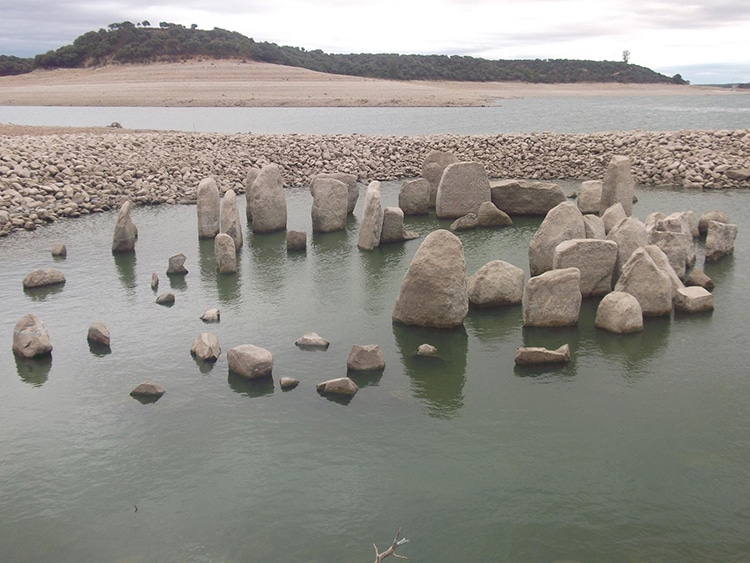
The Dolmen of Guadalperal, known as the “Spanish Stonehenge.” (Photo: Pleonr via Wikimedia Commons, CC BY-SA 4.0)
Megaliths are large stones used by prehistoric peoples to build monuments or structures. Perhaps the most famous example of a megalithic structure is Stonehenge in England. However, ancient (and often mysterious) stone structures can be found across Europe. In 2019, an unusually dry summer caused the waters of the Valdecañas Reservoir to recede, revealing a monument that has come to be referred to as the “Spanish Stonehenge.” NASA satellites captured images of the exposed stones known as the Dolmen of Guadalperal, which experts suspect may have been built sometime in the second or third millennium BCE.
The Dolmen of Guadalperal is a collection of 150 large granite stones arranged in a circular structure with what appears to be an entranceway guarded by a menhir (standing stone) carved with snake and cup motifs. The term dolmen is typically used to describe an ancient structure where standing stones support a large capstone to create a chamber—a structure often used for early Neolithic tombs. The Dolmen of Guadalperal likely once had a mounded top, and the chamber inside may have functioned as a tomb, a religious site, or a trading post along the Tagus River in southeastern Spain.
This ancient site was discovered in 1926 by the German archaeologist Hugo Obermaier, who also found artifacts from the suspected builders of the monument that suggested they lived nearby during its construction. In 1963, under the rule of Francisco Franco, the government flooded the area containing the Dolmen to create the Valdecañas Reservoir. Only the tips of the largest megaliths were visible above the waterline until the recent drought that struck Europe in the summer of 2019. With record low water levels, the Dolmen emerged in full for the first time in decades.
The drastic change in water levels and the emergence of the monument were seen by NASA's Operational Land Imager satellites. Between 2013 and 2019, a vast change in the reservoir depth can be seen. The Dolmen of Guadalperal—underwater for decades—was visible once more. The monument's engravings have eroded during its time submerged; the porous stones are not faring well. Some local residents have been advocating moving the stones to recreate the monument in safer territory. This step, they argue, would preserve the monument, promote tourism, and proudly display Spain's prehistoric history.
A megalithic stone monument known as the “Spanish Stonehenge” is the Dolmen of Guadalpera.

The monument in 2019. (Photo: Pleonr via Wikimedia Commons, CC BY-SA 4.0)
Discovered in 1929, it was later submerged underwater by the creation of the Valdecañas Reservoir in 1963.

The Dolmen of Guadalperal in the summer of 2012. (Photo: Pleonr via Wikimedia Commons, CC BY-SA 4.0)
The drought of the summer of 2019 caused the water levels to fall to historic lows, exposing the Dolmen in full.

The Valdecañas Reservoir on July 24, 2013. (Photo: NASA Earth Observatory images by Lauren Dauphin, using Landsat data from the U.S. Geological Survey)
This rare occurrence was captured by NASA satellites and has encouraged locals to advocate for the monument's relocation away from corrosive conditions.

The Valdecañas Reservoir on July 25, 2019. (Photo: NASA Earth Observatory images by Lauren Dauphin, using Landsat data from the U.S. Geological Survey)
Related Articles:
15,000-Year-Old Bison Sculptures Are Perfectly Preserved in a French Cave
Discovery of a 9,000 Year-Old Burial of a Female Hunter Challenges Prehistoric Gender Roles






















































































